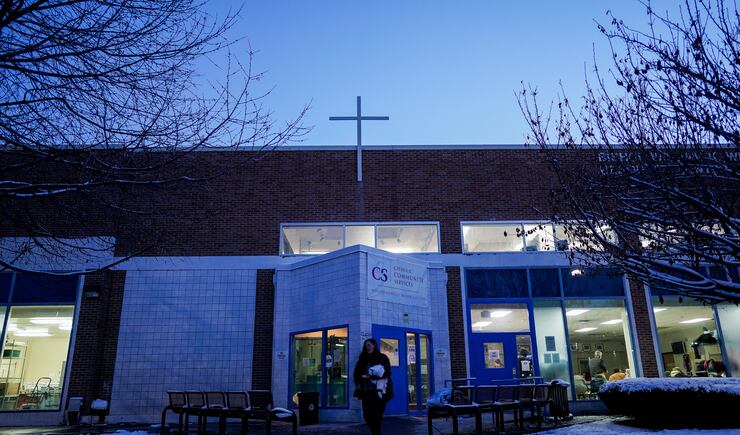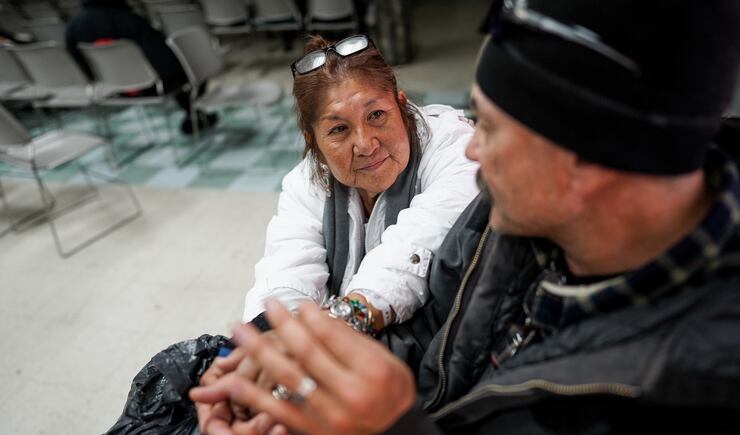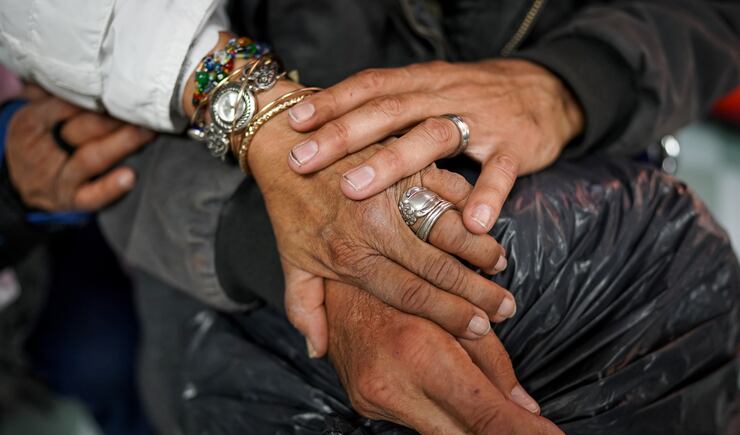SALT LAKE CITY — It was 30 degrees and dropping.
Nestled amid the season’s first snowfall were about a dozen tents and makeshift camps lining the parking strips near Salt Lake City’s Library Square on Tuesday. Among them, sitting beneath a tarp, Meghan checked her makeup in a hand-held mirror.
Meghan, who only gave her first name to the Deseret News, said she’s been homeless for about six months because she lost her job. She said she’s tried to get a bed at a new homeless resource center several times, but to no avail, and she’s reluctant to wait at one of the centers for hours until a bed may or may not free up. She said she’s stopped trying, afraid to leave her belongings — tarps, tents, blankets, and several suitcases — alone for too long in case they’re stolen or cleared away by clean-up crews.
Plus, Meghan said she’s heard the new resource centers go “overboard” with metal detectors and bag checks.
“It’s like going to jail,” she said.
As for the warming center at the Weigand Center downtown, Meghan said she won’t go near that area because her partner was “jumped” outside the downtown shelter. So instead, they find places to sleep on the streets near Library Square, breaking down camp and moving when police tell them to move along, only to set up again somewhere else.
“We’re just trying to make it day by day,” she said.
Around the corner, Brandon Stephens and his wife, Allie, set up their tent in the mud on a parking strip. A few yards up the street, muddy blankets, and clothes spilled out onto the road from a tangle of tarps and blankets, where a crowd of more people sat together.
That night temperatures dropped well below freezing Monday night, but Stephens said he and his wife slept on the street, keeping each other warm. Tuesday, they planned to sleep on the street again.
He said he didn’t plan on seeking a bed at the three new homeless resource centers that night. He said he’s tried before, but gave up when he was told he and his wife would be separated.
“I would rather stay with my wife,” he said, explaining he tried to get beds together, but that process became too complicated.
“I just try to do the best I can,” he said.
Resource centers lingering at capacity
The encampments and crowds of homeless on Library Square — just across the street from the Salt Lake City Public Safety building — have become increasingly prevalent, ever since Operation Rio Grande dispersed on-street camping in the Rio Grande neighborhood, where the Road Home’s downtown shelter operated for decades until it shut its doors last week as Utah leaders finished moving the homeless into three new homeless resource centers.
As of Tuesday, five nights had passed since the closure of the downtown shelter — and all three of the new homeless resource centers that cost upwards of $63 million in public and private dollars to construct have been lingering consistently at or near capacity, though availability is a nightly moving target.
Meanwhile, overflow capacity at St. Vincent de Paul’s Dining Hall has also been maxing out — but state officials still aren’t pulling the trigger on any additional emergency overflow plan.
They point to the Weigand Center’s overnight “warming center” as the place people can still go each night to get out of the cold. Additionally, state officials can draw down more money for motel vouchers, but they say they haven’t yet seen the need.
As of Monday night, the 300-bed South Salt Lake Men’s Resource Center was one bed away from maxing out its space, with 299 beds full. The other two centers — the 200-bed mixed-gender Gail Miller Resource Center and the women’s 200-bed Geraldine E. King Resource Center — were at full capacity, according to Nate McDonald, a spokesman with the Department of Workforce Services.
St. Vincent’s 58-mat overflow space also maxed out with a mix of men who either refuse to move to the new resource centers or who weren’t connected with any available beds, McDonald said.
While 98 people total “checked in” to the Weigand Center’s overnight warming center — a day center that is now open at night with capacity for up to 100 chairs — the center wasn’t maxed out at any point overnight, McDonald said, noting people come and go. Its occupancy Monday night lingered between 28 to 40 people at a time, according to three different counts at 10 p.m., 12:30 a.m., and 4:30 a.m., McDonald said.




Shelter-resistant
Bill Tibbitts, associate director of the Crossroads Urban Center, worries offering chairs instead of beds may be causing more people to turn to the streets rather than shelter, especially as temperatures continue to drop well below freezing at night.
“There have always been people who don’t want to stay in the shelter,” Tibbitts acknowledged. “At this moment, our concern is people who wouldn’t be classified as shelter resistant are because they don’t want to sit in a chair all night.”
But of the people staying on the streets who spoke to the Deseret News on Tuesday, several found it easier to pitch a tent than to try and get a bed at one of the new resource centers — or they simply weren’t interested in the Weigand Centers’ services, still intent on avoiding the Rio Grande area.
Homeless outreach workers from Volunteers of America, Downtown’s ambassador program, Catholic Community Services, Salt Salt Lake Police and others are all “working to understand” the needs of the “shelter-resistant,” McDonald said but it’s not a new problem facing Salt Lake County.
“We’ve always had a population that chooses to be unsheltered even in the winter,” McDonald said.
Utah’s 2019 homeless point-in-time count — an annual count that takes place on a single night in January to help survey the state’s homeless population — documented 193 unsheltered homeless people in Salt Lake County.
“We can’t forget these individuals have the freedom to choose,” McDonald said.
Of those who want a bed, it’s not clear how many of those using the warming center were there to simply get out of the cold compared to how many were seeking a bed. McDonald said there may have been a “handful,” but he wasn’t aware of any “waiting list” for people seeking beds.
McDonald also said he wasn’t aware — so far — of any people spending multiple nights at the warming center waiting for a bed. Each night, empty bed tallies at the new resource centers are taken at 8 p.m. and any vacant beds are opened up to people waiting.
Because it’s not permitted as an emergency shelter, the warming center isn’t intended to be an overnight sleeping area.
Daniel Gravley and his wife, Marilyn Peters, sat in the Weigand Center Tuesday evening, waiting for the daily shuttle to take them back to the mixed-gender Gail Miller Homeless Resource Center, where they both got beds to stay.
Their main complaint with the new center? The dogs that have been allowed to stay with their owners. Other than that, the couple said they were relieved to have the option to stay together in the same facility.
“By the grace of God, we are together,” Gravley said, holding Peters’ hand.






